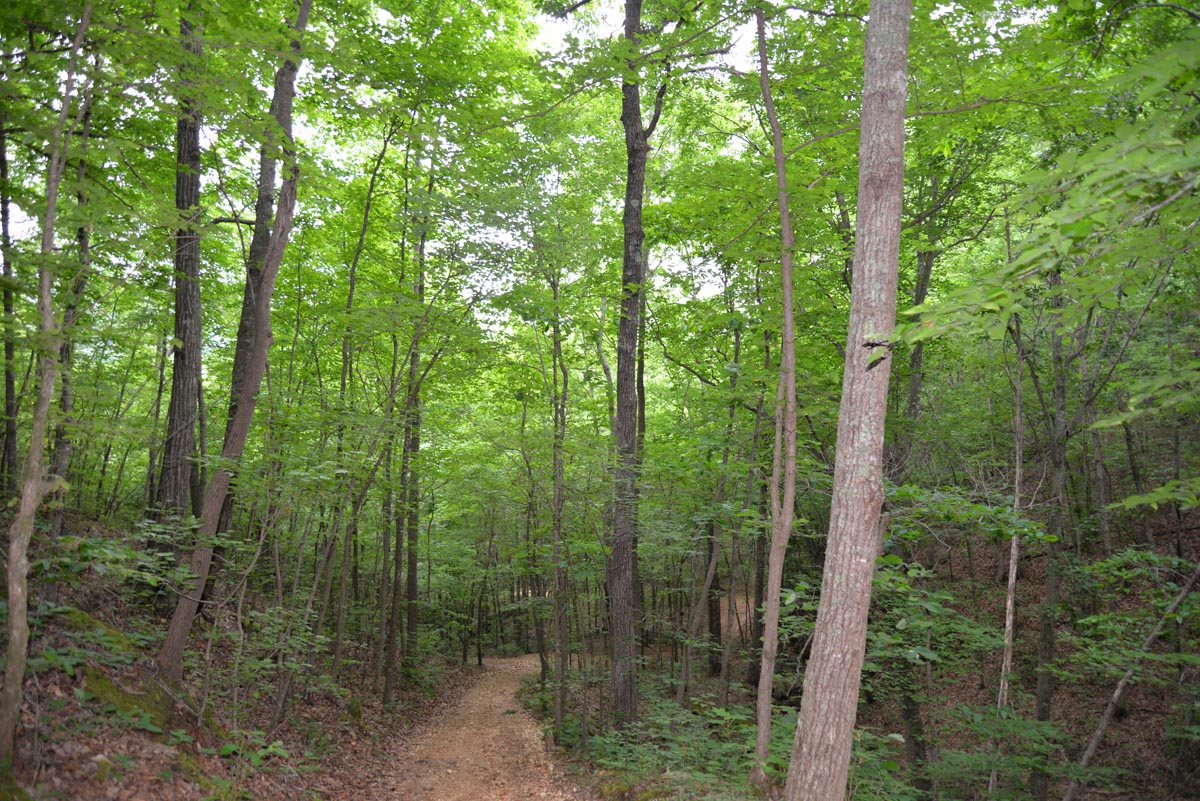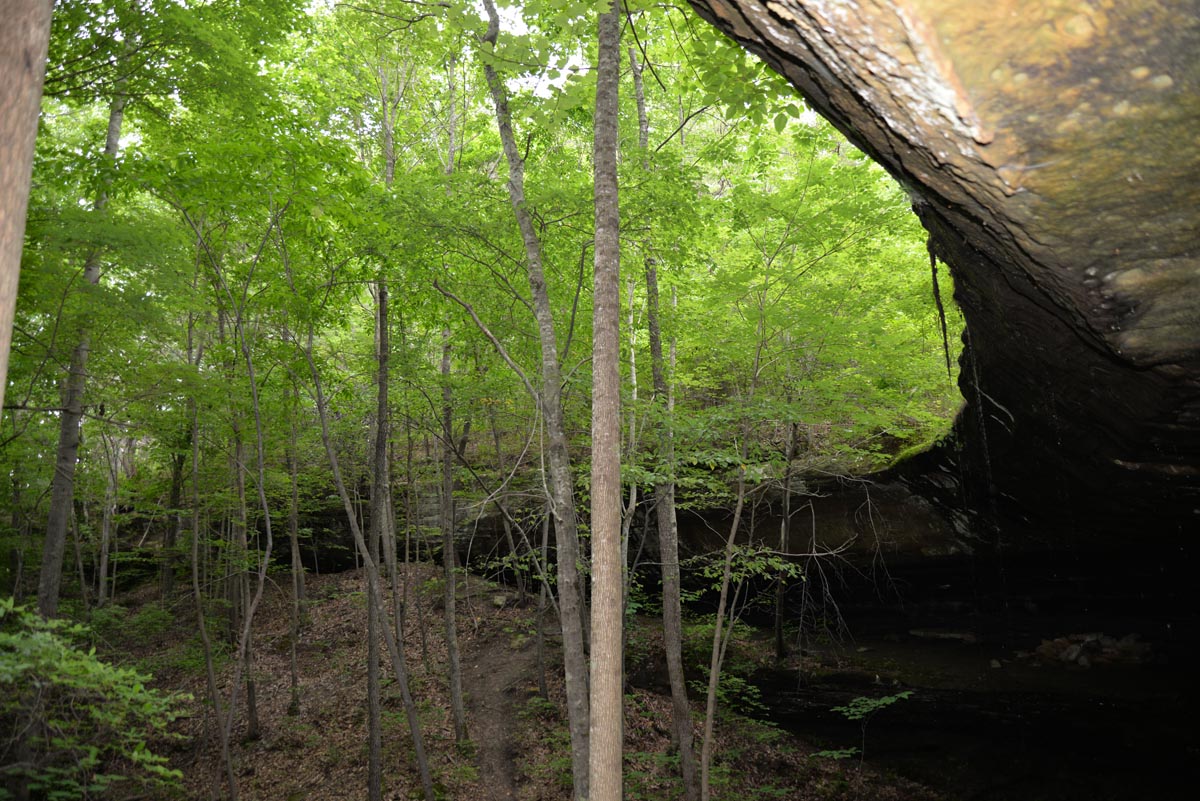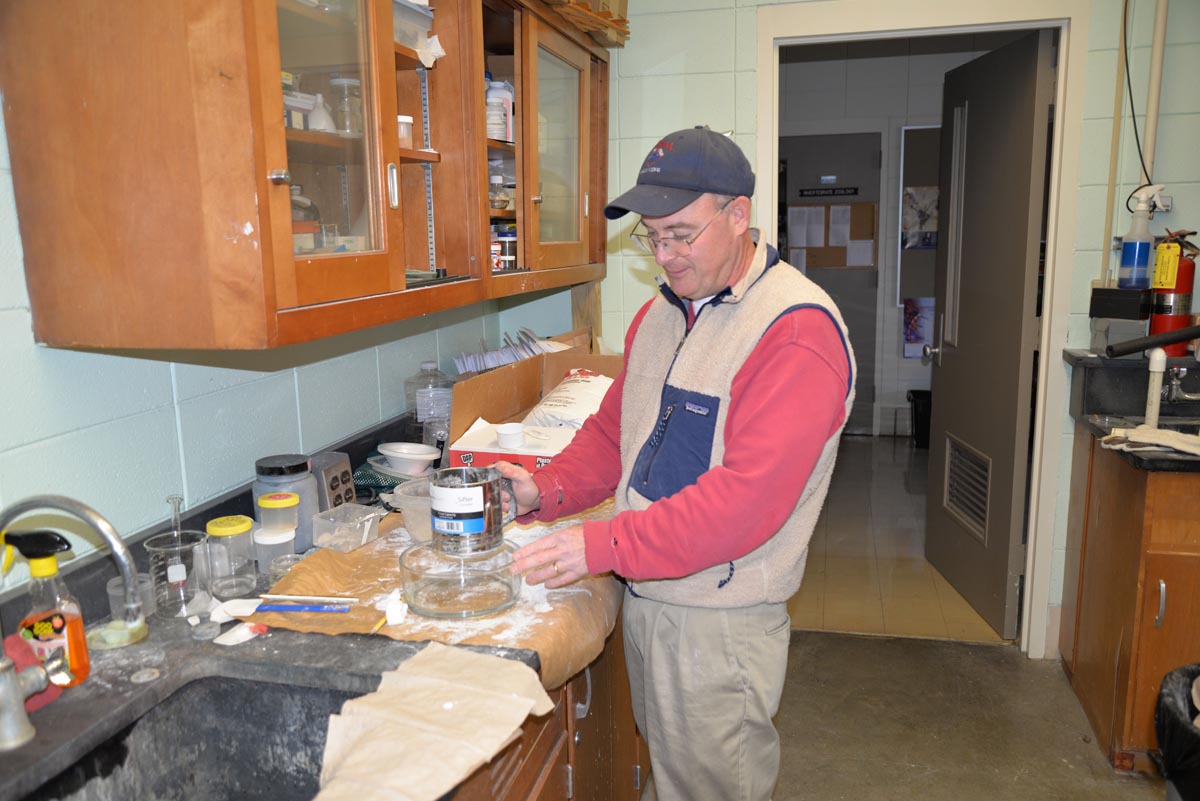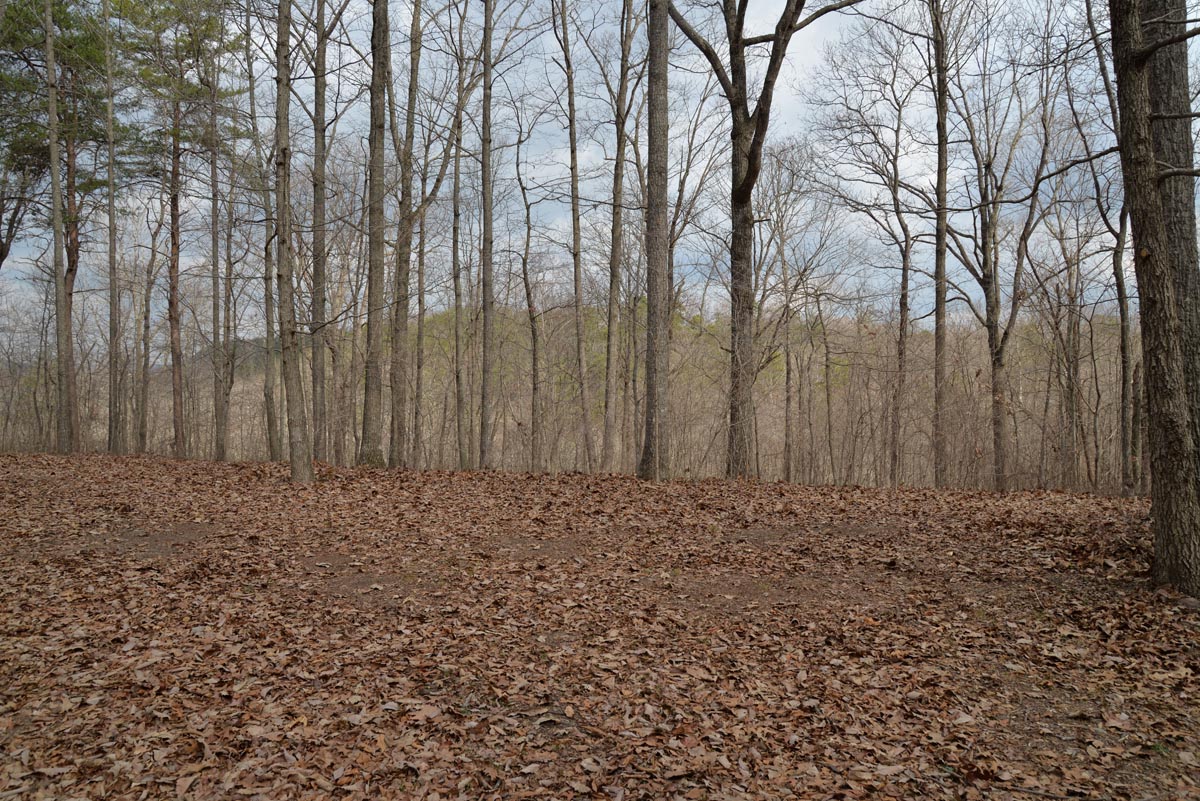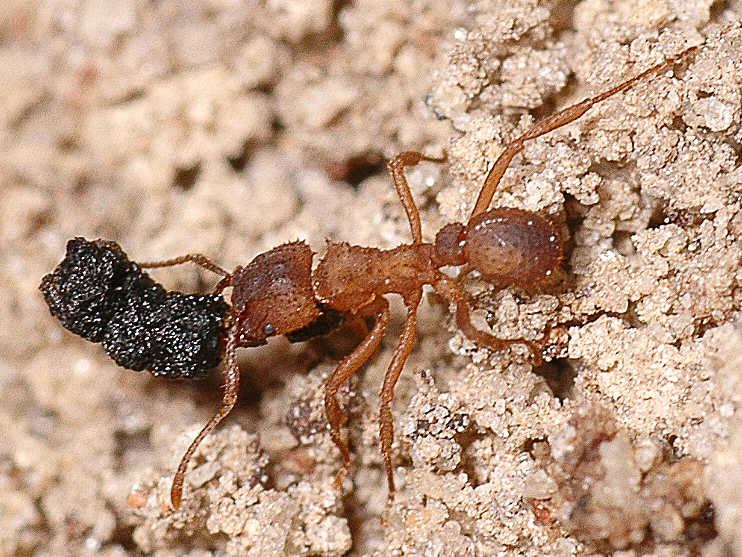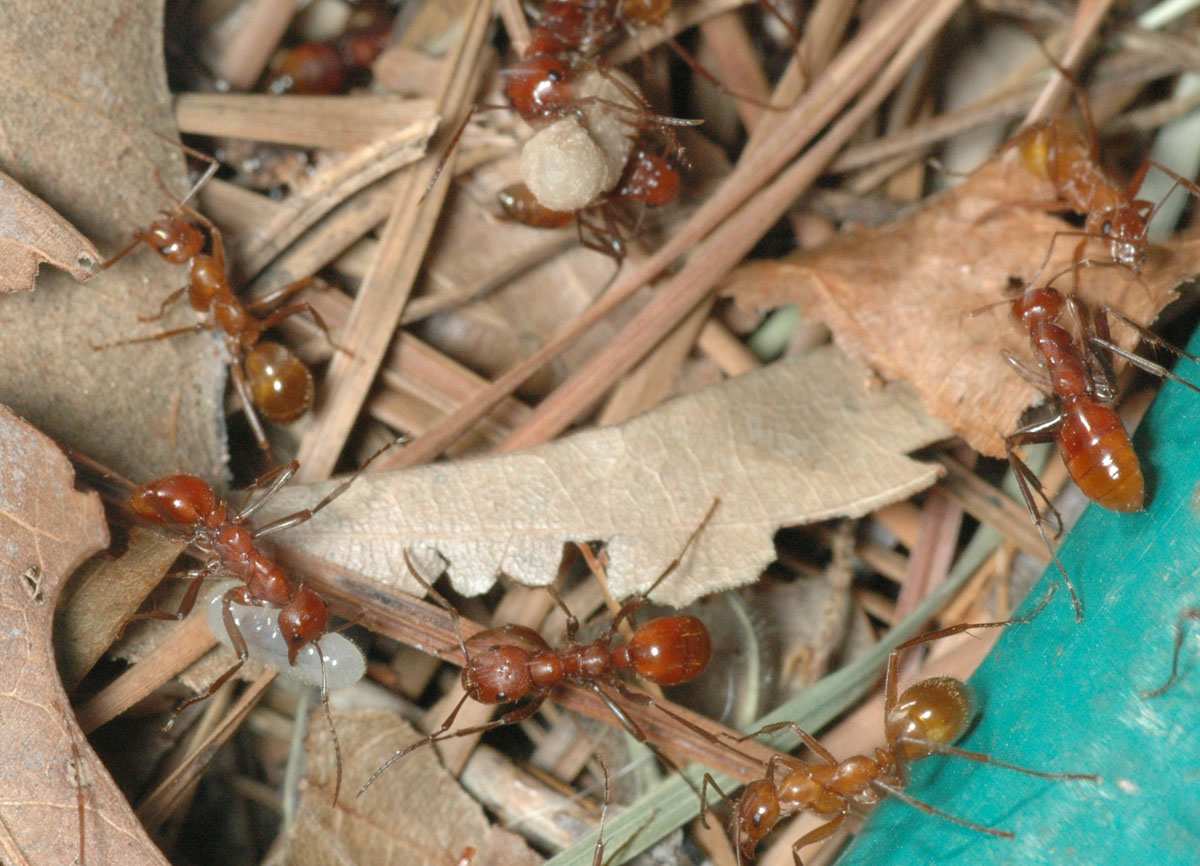Ants of Cane Creek Canyon Nature Preserve, Colbert County, Alabama
by Joe A. MacGown1, James G. Lewis1, and Paul Davison2
1Mississippi Entomological Museum, Mississippi State University, MS 39762
2University of North Alabama, Florence, AL 35632
Uploaded on 11 June 2014
The Cane Creek Canyon Nature Preserve is located in the Little Mountain region of Colbert County, Alabama. This beautiful 700+ acre preserve is privately owned and maintained by Jim and Faye Lacefield, but has been granted official status as a nature preserve through a conservation easement with The Nature Conservancy of Alabama. Many thanks to the Lacefield's for allowing the public and researchers to visit this unique property.
A view of one of the trails in early JuneThe preserve is a part of a complex of small sandstone canyons located in the upper portion of the Cane Creek watershed of the Tennessee River basin. Waterfalls, rocky creeks, creek cascades, boulder fields, and rock shelters are common geographic features of the rocky sloped ravines and steep hills that typify this area. Much of the preserve is populated by hardwoods, with scattered pines at higher upland elevations, scattered open glades, and wet mesic habitats in low areas. Numerous well-maintained trails wind through the various habitats, and the Lacefields have even provided picnic tables, water stops, and bathrooms at different points along the way.
One of the interesting rock overhangs at the preserveNumerous researchers have studied various taxa at the preserve, but until recently, the ants had not been studied or surveyed here. With its close proximity to the University of North Alabama (UNA), this area made an ideal site for Paul Davison (Biology Professor, UNA) to test the efficacy of his plaster based trap nests that he designed for collection of cavity nesting ants species. Following Paul's suggestion, Mississippi Entomological Museum (MEM) staff members Joe MacGown and James Lewis decided to make at a least a couple of trips to the preserve to hopefully add to the species list started by Paul. The aim was not to do a thorough survey of the preserve, but mostly to get an idea of the common species of ants present, as well as note any unusual species.

Stigmatomma pallipes, the Dracula antThe first trip to the preserve by MEM researchers was made from 24-25 March 2014. Before arriving at the preserve, we visited Paul's office at UNA so we could observe his methods of making trap nests and also to view his live colonies of various species of Strumigenys (mini trapjaw ants in the tribe Dacetini). Paul is the quintessential biology professor with 500 things going at one time. He studies a little bit of everything it seems, and has got the "ant bug" as of late. With his colonies of dacetine ants, Paul has witnessed behaviors that no one else has seen for some of these species. This is exactly why the trap nests that he has designed, and those that other researchers such Doug Booher and Rick Duffield have designed, are so important. Dacetine ants are minute and amazingly cryptic. Its rare to find a colony in the soil or leaf litter, despite the fact that they are much more common than researchers historically assumed. We now regularly collect them with litter sampling techniques, but unfortunately, dead specimens do not offer us much insight into their behavior.
Paul Davison in his lab creating nest trapsAfter our visit at UNA, all three of us headed over to the Preserve. Today was not ideal, as it was fairly chilly, but it was a good time for us to visit, and Paul had some rare "free" time to show us around. Upon arriving at the property, we met Jim Lacefield, who gave us a quick overview of the preserve. Then we started up the main trail through an open, upland forest.
At this time of year, and especially with the cold weather, we did not expect to find lots of ants moving around. Of course, we did see plenty of workers of the winter ant, Prenolepis imparis, foraging on the ground and performing basic nest care duties. Several other common species were seen as well, and we collected a few voucher specimens of each. We found two species of acrobat ants: Crematogaster ashmeadi and C. lineolata, the former crawling about on trees and the latter nesting in rotting wood and in leaf litter. We noted incipient colonies of the long legged Aphaenogaster carolinensis in the soil just under the leaf litter layer. This is a common woodland species that typically has relatively small nests. Although belonging to the Myrmicinae subfamily, which includes many stinging species, this genus has a atrophied nonfunctional stinger. Of course, we found the common cavity inhabiting Temnothorax curvispinosus, a beautiful little yellow ant with long, curved propodeal spines. Another member of that genus, T. pergandei, was discovered in the leaf litter. This species ranges in color from an orangish-red to almost black depending on the habitat it is collected in. At various points in time, these color forms have been considered to be separate subspecies, and who knows, maybe they are actually different subspecies or even species? Myrmecina americana, a common and widespread litter dwelling ant, was also found. This interesting species with two pairs of propodeal spines becomes inactive when disturbed, as do several other litter inhabiting ants species such as Ponera pennsylvanica, which we also collected in the leaf litter. Probably the highlight of the trip was finding Discothyrea testacea, an unusually looking, minute, yellow species that nests in leaf litter.
Discothyrea testacea, note the enlarged apical antennomereTwo species of Formica, which includes large sized species that typically nest in mounds, were collected. These species, F. dolosa and F. subsericea, the former of which is colored a beautiful pubescent golden orange and the latter of which is pubescent dark brownish-black, both nest in the soil. In our region, colonies of F. dolosa are often fairly inconspicuous, being completely underground and noted only by an entrance hole, although we have seen moderate sized mounds nestled amongst grasses and have even seen them nesting in rotting wood with colonies extending in the soil beneath. On the other hand, F. subsericea colonies can be extremely large and conspicuous with colonies sometimes being well over 1.0m in diameter and about 0.5m in height.
We only noticed two exotic species during this trip, Solenopsis invicta X richteri (the hybrid imported fire ant) and Nylanderia vividula. Both of these species have become so embedded in our region, that they are basically residents at this point in time. A relative of the fire ant, Solenopsis carolinensis, a minute, golden thief ant, was found in leaf litter in the woods.
Due to the cool weather, we spent some of our time exploring the area with the knowledgeable Paul Davison pointing out interesting plants and other points of interest. As we traveled up and down from upland hardwood forests to low mesic areas crisscrossed by creeks, we eventually made our way to a beautiful scenic overlook. While there, we looked in acorns for colonies of ants. Colony size of ants is greatly variable ranging from the exceedingly large colonies of leafcutter ants in the genus Atta to the extremely small nests of dacetine ants. In fact, many species of ants are tiny and may have small colonies. Naturally formed artificial cavities, such as acorns or hickory nuts that have already been hollowed out by some other type of insect, provide a welcoming shelters for the queens of these minute species to raise their families. It was not long before Paul found a colony of Temnothorax pergandei nesting in an acorn! Similar to most species that utilize acorns, hickory nuts, hollow twigs, and other cavities on the ground for nest sites, T. pergandei also nests in soil and leaf litter.
We eventually made our way around a loop trail, and, with daylight quickly leaving us, we headed out for some supper! We had planned on collecting litter samples the next morning, but a strong cold front swept through the area that night leaving us with unseasonably frigid temperatures and even some snow flurries! So, needless to say, we did not do any litter collecting in the now cold and wet forest. We did hike around exploring some more and took additional photos of the area.
We made a return trip to Cane Creek Canyon from 2 to 3 June 2014. This time, the weather was much more conducive to collecting ants. That is to say, it was hot! Paul was already at the site putting out some of his trap nests when we arrived. We got to work beating branches of trees and shrubs for arboreal species and ground nesting species that forage on plants or tend hemipterous insects for honeydew. We also baited several larger oaks with peanut butter, a known method for attracting some species that nest in trees. Visual scans of the open wooded area near the first picnic site revealed numerous nests the bigheaded ant Pheidole bicarinata. This is a common ground nesting species that seems to prefer dry, open habitats with patches of bare ground. Campsites, picnic areas, and trails are good places to look for them. At first glance, one might note the small holes in the ground, often surmounted by smalls mounds of dirt. Typically, this species has numerous colonies in the same area. But, unless you look closely, you will not likely spot the tiny minor workers as they scurry about foraging for food. The larger major workers, with their proportionally huge heads, are generally timid, and not usually seen unless a good food source is identified by the minors. However, these majors can be enticed from their subterranean labyrinths with bits of cookies or something comparable. Foraging along side of the Pheidole were large numbers of the little black ant, Monomorium minimum, which nests in soil, in wood, various cavities, and even invades homes.
With the fine dusty to sandy soil present in the upland areas and steep slopes, we expected to see colonies of our native leaf cutting ant, Trachymyrmex septentrionalis, and we were not disappointed. Hundreds of colonies were noted in the area, with the first ones seen in the same open area near the picnic sites. This species also nests underground, and its nests can be picked out by the distinctive crescent shaped mound of of dirt above the soil level. This is a fascinating species both visually and behaviorally. Strange in appearance, with irregularly shaped spines projecting from the body, this reddish brown species is known to grow fungus gardens for its primary food source. Gardens are cultivated in hollow chambers below ground and grown on a substrate of leaf bits and insect feces. Unlike many leaf cutting relatives in the tropics, colonies of this species are relatively small and pose no serious threat to tree stands. If you take the time to watch these extraordinary creatures, especially during a cooler part of the day, you may be rewarded by seeing workers carrying small bits of leaves, insect droppings, or other material in their mandibles to their colonies, while other workers carry out nest-care duties such as removing bits of soil from the tunnels below and placing them on the cresentic mound above!
Trachymyrmex septentrionalis, the fungus growing antForaging workers of the resplendent golden orange colored Formica pallidefulva were observed moving quickly along the ground in this same open wooded habitat. With a bit of diligence, workers were followed to their nests, with several nests being discovered. In each case, the nest was relatively inconspicuous, being marked by some loose dirt surrounding a pencil erasure sized hole in the ground. This common ant is host to a slave making species of ant, Polyergus montivagus, the genus of which has not yet been recorded in Alabama. With the numerous colonies of this species of Formica and F. dolosa and F. subsericea, it would be a great place to look for Polyergus, who's raids on Formica colonies are legendary. Polyergus is known to raid at the same time of day in early to mid summer, usually late afternoon to dusk depending on the species. Raids are easy to spot, as columns of Polyergus march purposefully to a Formica colony where they boldly carry off Formica brood in their specially designed sickle shaped mandibles. The young Formica will be reared in the Polyergus colony where they will eventually fulfill all nest care, nest building, and foraging activities.
Polyergus workers carrying Formica larvae and pupae (in cocoons) back to their colonyThe peanut bait on the trees attracted several species including Crematogaster ashmeadi and Temnothorax schaumii. Both of these species are common tree nesting species, with the latter typically thought to be less common. However, this species is actually quite widespread and abundant, just under-collected due to its cryptic nature. Even at the bait, workers are difficult to spot, as they are slow moving, often confine themselves to the little cracks and crevices of the bark, and have coloration that enables them to blend in with the bark. Workers of the carpenter ant Camponotus snellingi, a bicolored species, were found on trees and also collected by beating branches. We again collected Temnothorax curvispinosus from branches and in leaf litter, along with Prenolepis imparis.
Walking along the main trail, we observed numerous foraging workers of Formica subsericea. This species was the most obviously seen ant at the preserve and much more common than during our first visit back in March. During the course of the afternoon and then again the following morning, we conducted random sampling at five localities including the first open site, along the hilly trail heading toward the overlook, the overlook site, near the base of the steep trail, and along the canyon creek site (for more site info, see below). Litter sampling from this trip was notably more productive than in March, and we added several interesting species to our total including the Dracula ant, Stigmatomma pallipes; two species of the strange looking Proceratium, P. crassicorne and P. pergandei; and several dacetine species (see list below). As alluded to earlier, dacetine ants are most easily collected by taking litter samples back to the lab and running them through a Berlese funnel extractor. Of the seven species we collected, Strumigenys angulata was perhaps the most interesting. This is a species we regularly find in healthy upland hardwood forests, although only a few years ago, this species was considered rare.
We added several other common woodland species to our list including Aphaenogaster fulva and A. lamellidens, both wood nesting species; Pheidole dentigula (common in leaf litter); Pheidole dentata (nests in soil and wood, common at the preserve); Pheidole tysoni (nesting in soil along the open trail through the woods); Brachymyrmex depilis (a minute, yellow species that nests in the soil and hollow nuts, found mostly in mesic areas of the preserve); Crematogaster minutissima (a minute yellow species of acrobat ant that lives in mesic to slightly xeric forests); and the common woodland ant Nylanderia faisonensis.
We collected a total of 39 species, most of which we found on the second trip alone! Subsequent collecting at this site could easily double this species total, or at least come close. To see more photos from our trip visit Joe MacGown's Ant Blog: Ants of Cane Creek Canyon Nature Preserve.
List of ant species collected at Cane Creek Canyon Nature Preserve (arranged alphabetically by genus)
Aphaenogaster carolinensis (Wheeler)
Aphaenogaster fulva Roger
Aphaenogaster lamellidens Mayr
Brachymyrmex depilis Emery
Camponotus snellingi Bolton
Crematogaster ashmeadi Mayr
Crematogaster lineolata (Say)
Crematogaster minutissima Mayr
Discothryea testacea Roger
Formica dolosa Buren
Formica pallidefulva Latreille
Formica subsericea Say
Hypoponera opacior (Forel)
Monomorium minimum (Buckley)
Myrmecina americana Emery
Nylanderia faisonensis (Forel)
Nylanderia vividula (Nylander)
Pheidole bicarinata Mayr
Pheidole dentata Mayr
Pheidole dentigula Smith
Pheidole tysoni Forel
Ponera pennsylvanica Buckley
Prenolepis imparis (Say)
Proceratium crassicorne Emery
Proceratium pergandei (Emery)
Solenopsis carolinensis Forel
Stigmatomma pallipes (Haldeman)
Strumigenys angulata Smith
Strumigenys clypeata Roger
Strumigenys louisianae Roger
Strumigenys ohioensis Kennedy & Schramm
Strumigenys ornata Mayr
Strumigenys rostrata Emery
Strumigenys talpa Weber
Trachymyrmex septentrionalis (McCook)
Temnothorax curvispinosus Mayr
Temnothorax pergandei Emery
Temnothorax schaumii Roger
Trachymyrmex septentrionalis (McCook)
Study Sites
Site 1 (open woods near bathrooms at trailhead)
AL,Colbert Co.
Cane Creek Canyon N.P.
34°37'18"N 87°47'48"W
upland hardwood forest
Site 2 (trail near waterfall)
AL,Colbert Co.
Cane Creek Canyon N.P.
34°37'14"N 87°47'57"W
upland hardwood forest
Site 3 (overlook)
AL,Colbert Co.
Cane Creek Canyon N.P.
34°37'24"N 87°48'10"W
upland hardwood forest
Site 4 (Steep Trail)
AL,Colbert Co.
Cane Creek Canyon N.P.
34°37'25"N 87°48'11"W
hardwood forest on
rocky ravine slope
Site 5 (Cane Creek Trail)
AL,Colbert Co.
Cane Creek Canyon N.P.
34°37'12"N 87°48'15"W
mesic, rocky, sloped
hardwood forest
Links
Joe MacGown's Ant Blog: Ants of Cane Creek Canyon Nature Preserve


